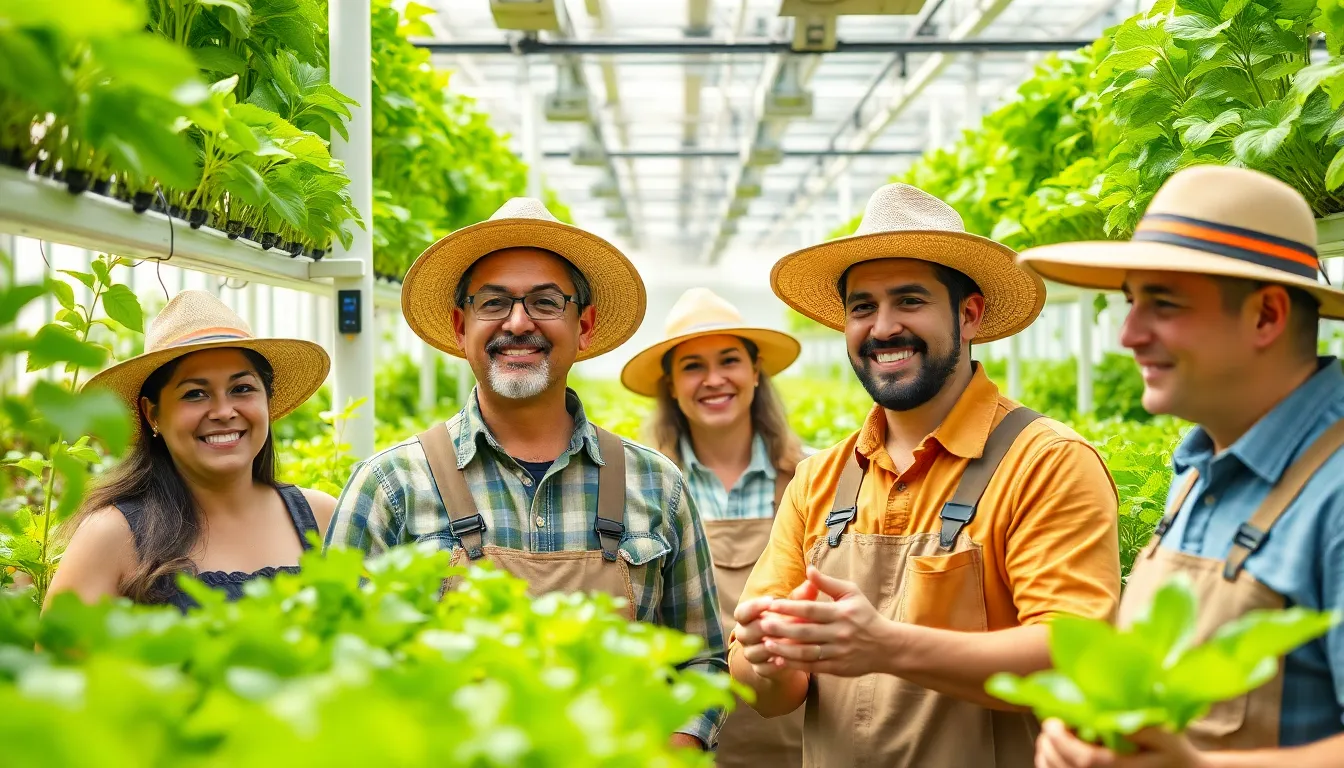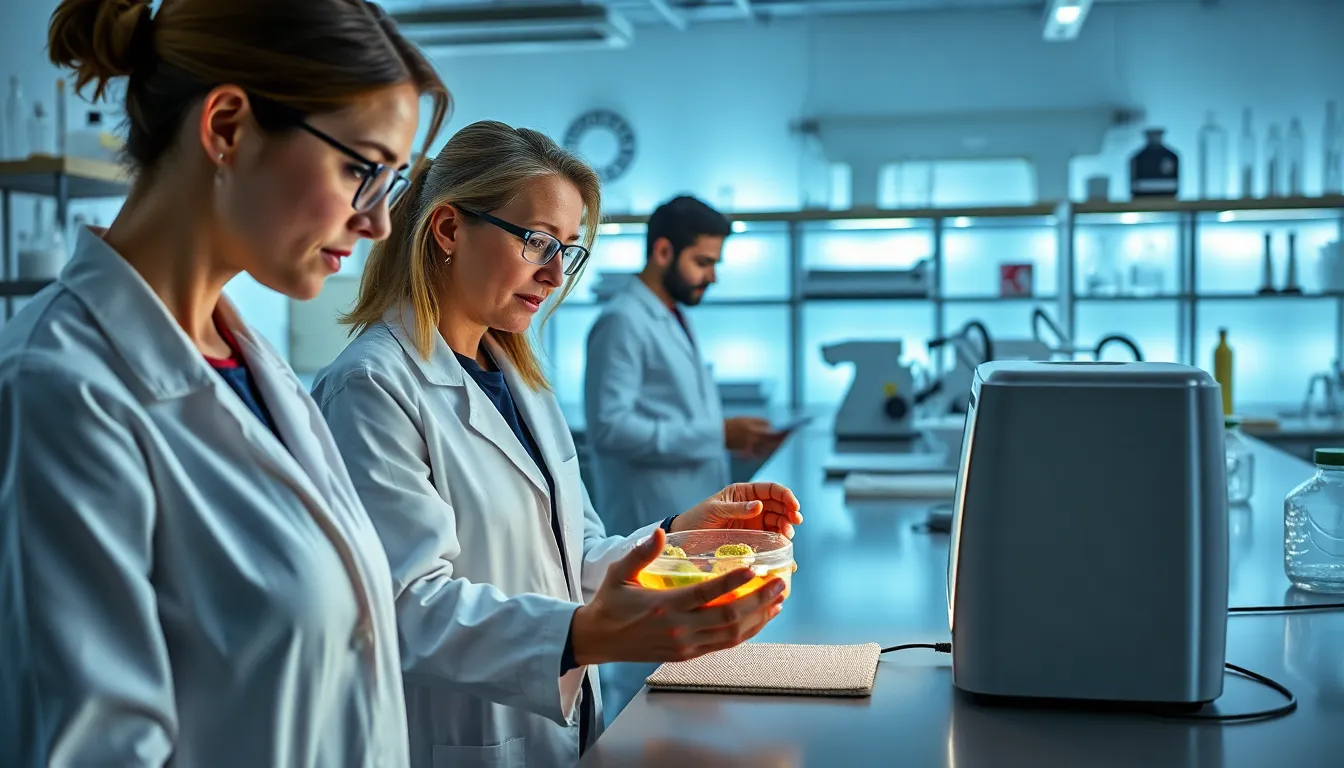Table of Contents
ToggleFood science and technology isn’t just about whipping up the perfect soufflé anymore. It’s a thrilling rollercoaster ride of innovation where lab coats meet culinary creativity. From lab-grown burgers to smart kitchen gadgets that can practically cook for you, the food landscape is evolving faster than you can say “umami.”
As consumers become more health-conscious and environmentally aware, the demand for cutting-edge solutions is skyrocketing. Food scientists are stepping up to the plate, blending science with flavor to create sustainable and nutritious options that’ll make even the pickiest eaters smile. So buckle up and get ready to explore the delicious trends reshaping our plates and palates. Who knew science could taste this good?
Overview of Trends in Food Science and Technology
Food science and technology are evolving rapidly, reflecting consumer preferences and environmental concerns. Lab-grown foods gain traction as individuals seek alternatives to traditional agriculture. Innovations in cellular agriculture lead to the creation of meat and dairy products that require fewer resources for production.
Sustainable practices drive advancements in food preservation. Techniques like high-pressure processing and natural preservatives enhance shelf life while maintaining nutritional value. Additionally, these methods minimize food waste, aligning with the global push for sustainability.
Smart kitchen gadgets continue to transform meal preparation. Devices incorporating artificial intelligence offer personalized cooking recommendations based on dietary needs and preferences. Connectivity features in appliances allow for seamless monitoring and control via smartphones, optimizing cooking efficiency.
Plant-based diets rise in popularity, prompting research into new protein sources. Ingredients such as lentils, chickpeas, and pea protein become mainstream, taking center stage in various products. This shift not only caters to vegetarians and vegans but also appeals to flexitarians.
Functional foods emerge as consumers prioritize health benefits. Products fortified with probiotics or Omega-3 fatty acids address specific health concerns, from gut health to heart health. Understanding consumer demands drives food scientists to innovate continuously.
Nutrigenomics, the study of how diet influences gene expression, becomes crucial. Research in this area helps create tailored nutritional profiles for individuals, enabling personalized diets that consider genetic makeup. As knowledge in this field expands, food technology adapts to better serve diverse populations.
Sustainable Food Production

Sustainable food production involves innovative practices that meet current culinary demands while preserving resources for future generations. This concept intertwines advancements in agriculture and waste reduction.
Innovations in Agriculture
Technological advancements significantly enhance agricultural efficiency. Vertical farming utilizes limited space, allowing for higher yields in urban environments. Automated systems and data analytics optimize crop management, promoting resource efficiency. Moreover, precision agriculture employs sensors and drones, ensuring accurate water and nutrient delivery. Cultivating lab-grown proteins introduces meat alternatives that minimize land and water use. Enhanced soil health through regenerative practices supports crop resilience and biodiversity, promoting sustainable ecosystems. Integrating these innovations transforms traditional farming methods and aligns food production with environmental sustainability goals.
Reducing Food Waste
Addressing food waste is crucial in sustainable food production. Implementing smart inventory systems enables retailers to monitor stock levels and minimize spoilage. Food preservation techniques, such as high-pressure processing, prolong shelf life, preventing waste. Educating consumers about meal planning and proper storage techniques significantly decreases household waste. Additionally, food recovery programs connect surplus food with local charities, redirecting it from landfills to those in need. Utilizing byproducts in innovative ways, such as creating animal feed or compost, contributes to a circular economy. Streamlining these processes ensures that more food reaches consumers while reducing environmental impact.
Food Safety and Quality
Food safety and quality remain at the forefront of advancements in food science and technology. Innovations in these areas focus on protecting consumer health and ensuring high-quality food products.
Advanced Testing Methods
Advanced testing methods enhance food safety by detecting contaminants quickly. Rapid microbiological tests and molecular techniques identify pathogens such as Salmonella and E. coli in less than a day. Real-time monitoring and detection systems provide food manufacturers with immediate feedback, decreasing the potential for widespread foodborne illnesses. Additionally, technologies like next-generation sequencing allow detailed analysis of microbial communities in food products, facilitating deeper understanding of safety risks. The integration of these methods strengthens public health initiatives and builds consumer trust.
Traceability Technologies
Traceability technologies play a critical role in ensuring food quality and safety. The implementation of blockchain offers transparent tracking of food products from farm to table. This technology allows consumers to access information about the sourcing and processing of their food, enhancing confidence in its quality. RFID tags and QR codes further streamline this process, enabling quick information retrieval with minimal effort. Companies that adopt these technologies can efficiently manage recalls, minimizing the impact of contamination incidents. Overall, improved traceability supports more resilient food systems and aligns with increasing consumer demand for transparency.
Nutrition and Health
Nutrition and health innovations within food science highlight the evolving relationship between diet and wellness, responding to consumer preferences for healthier choices.
Functional Foods and Ingredients
Functional foods play a pivotal role in modern diets. These foods include those fortified with probiotics, Omega-3 fatty acids, and antioxidants, addressing specific health needs. Labeling these foods as beneficial enhances their appeal. Research shows that regular consumption of functional ingredients contributes to improved gut health and reduced inflammation. Popular examples include yogurt enriched with probiotics and snacks featuring added fiber. As consumer awareness increases, demand for functional foods continues to rise, driving manufacturers to expand their product lines to meet this trend.
Personalized Nutrition
Personalized nutrition emphasizes tailored dietary approaches based on individual genetics and lifestyle factors. Nutrigenomics explores how specific genes affect nutrient metabolism, paving the way for customized dietary recommendations. Companies now develop personalized meal plans and supplements tailored to individual needs. Utilizing genetic testing, consumers can receive insights into optimal food choices that enhance health. Personalized nutrition not only improves overall well-being but promotes adherence to dietary guidelines. As technology advances, the potential for widespread adoption of personalized nutrition solutions grows, presenting an exciting opportunity in the food science landscape.
Emerging Technologies
Emerging technologies significantly influence food science and technology. Two key areas of advancement are biotechnology and artificial intelligence.
Biotechnology in Food Development
Biotechnology plays a crucial role in developing innovative food products. Scientists use genetic engineering to enhance crop yields, improve nutritional profiles and resist disease. This advancement leads to fortified foods that offer increased health benefits. For instance, methods such as CRISPR allow for the precision editing of genes in plants. These technologies enable the creation of crops with longer shelf lives and improved flavor. Additionally, lab-grown meats produced through cellular agriculture exemplify how biotechnology addresses environmental concerns by reducing resource use. As consumer demand shifts, biotechnology paves the way for sustainable and appealing food options.
Artificial Intelligence in Food Processing
Artificial intelligence transforms food processing through efficiency and customization. AI algorithms analyze vast amounts of data to optimize production processes. These systems assist in minimizing waste and ensuring consistency in product quality. Predictive analytics enable manufacturers to forecast demand, facilitating better inventory management. Personalized dietary recommendations are made possible through AI, enhancing consumer experiences. In smart kitchens, interconnected devices use AI to provide real-time cooking guidance. This innovation leads to more efficient meal preparation while appealing to health-conscious consumers. Overall, AI supports advancements in food processing, aligning with trends toward sustainability and personalization.
The landscape of food science and technology is evolving rapidly as innovations reshape how food is produced and consumed. With a strong focus on sustainability and health, advancements like lab-grown foods and smart kitchen devices are not just trends but essential shifts in the industry. As consumers become more aware of their choices, the integration of biotechnology and AI will continue to drive personalized nutrition and food safety.
These developments promise to create a more efficient and transparent food system that meets the diverse needs of today’s society. Embracing these trends will not only enhance culinary experiences but also contribute to a healthier planet for future generations.







